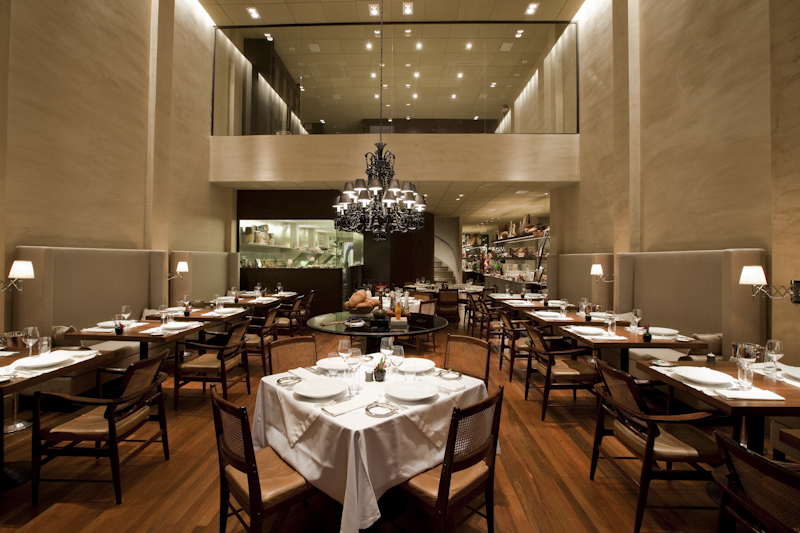
What’s in a sorbet? Forget acerbic, citrussy palate-cleansers: at São Paulo’s D.O.M., San Pellegrino’s fourth best restaurant in the world (as of 2012 – it’s been climbing the charts year on year) they use cheesy potato. Brazil’s national dish – one that had become very dear to my heart, in addition to possibly obstructive of its arteries – is pao de quiejo, a squidgy, nursery-food take on cheese bread; at D.O.M., chef Alex Atala has deconstructed this staple of the local diet into a mid-meal magic show. Your server twines the substance like clay in the air, aerating and growing it, before delivering to your plate a great heap of the stuff. It is – the babyish word is so apt – scrumptious. You wonder if it’d be gauche to order seconds.
You enter D.O.M. through imposing doors two storeys tall; the room has an improbably high ceiling, and, goldenlit, moderately sepulchral in atmosphere and rich in colour (I have an overwhelming memory of deep violet damask), there is something of the mausoleum about the environment. Amazonian artefacts, from tools-cum-weapons to creepy-cute animal effigies, line shelves at the back of the room; the huge circular table at the centre of the room has a gap cut out at its centre, as if something unearthly might emerge there partway through your meal. You’d be forgiven for being slightly distracted from noticing these details, though, by the incessant camera flashes going off around you, as if a major celebrity had entered. In fact it’s D.O.M. itself that’s the superstar: the briefest of internet searches will attest to the fact that nobody who dines here wants the fact to go unrecorded. Blogs are filled with identical pictures of the food — every dish that arrives at the table, set down by a punk-haired waitress, her arms covered in esoteric tattoos — is uploaded to Instagram before a morsel of it has touched the lips. It makes for a sort of hyperreal experience. I was reminded of Don DeLillo’s novel White Noise, which features a tourist attraction called “The Most Photographed Barn in America”, a myth that continually embroiders itself, as tourists flock to photograph the endlessly photographed, but which is empty at its heart. (The same cannot be said of this restaurant, of course, though I was uncertain whether we were dining at D.O.M., or “dining at D.O.M.” — a distinction which reviewing the place subsequently doesn’t necessarily help me make.)
Every dish that arrives at the table, set down by a punk-haired waitress – her arms covered in esoteric tattoos – is uploaded to Instagram before a morsel of it has touched the lips
There’s nothing sinister — though plenty transcendental — about Alex Atala’s food, however, which reworks traditional Brazilian flavours and ingredients into lively, very grown up dishes. We opted for a ten course tasting menu, and struggled afterwards to identify a single real disappointment. From an overwhelmingly beautiful green tomato jelly studded with edible flowers, microherbs and tomato seeds, to a splendid twist on fettucine carbonara in which local heart of palm, shaved to “noodles” of a millimetre’s thickness, replaces pasta, this is tremendous food, put together with dash and confidence. Crucially, it never loses grip on what diners actually want to eat. A breaded oyster with tapioca and salmon roe is a marvel of textures, at once succulent, crisp and pleasingly gelatinous. If pressed, however, I’d suggest that the costelinha ao malbec com mandioca Brás – a ray-like piece of fish with a Malbec foam and, oddly, a small boiled potato – seemed a little prosaic (not to be a slave to the traditional, but I didn’t find Malbec and white fish the happiest matching).
The meal concludes with two desserts. I wasn’t bowled over by the first of these, which presents thin sheaves of green papaya topped with a sort of yoghurt snow. This feels like a very elaborate sorbet. The flavours are agreeably subtle, and like everything else on the menu it looks beautiful and sculptural, but ultimately underripe papaya doesn’t quite hit my sweet tooth’s sweet spot. Much more convincing is the dish that follows. It has, oddly, the look of something one might attempt at home: a tiny, moist brazil-nut sponge cake, served on a swirl of dark chocolate dusted with powdered curry, pimento pepper and salt. A subtly whiskey-flavoured ice cream, finished with a vivid sprig of baby rocket, completes a low-key but spectacular course. Like D.O.M.’s other dishes, this is deceptively straightforward food, but with a precision of detail and flavour that are unimpeachable, made possible with sorcerous technique: something I learned when I did try to make it at home. The sponge, a sort of modified friand, is perfectly achievable (it did necessitate buying little individual loaf tins, but I’d never gripe about the opportunity to shop for abstruse one-use-only kitchen equipment), but the balance of the spices for the chocolate, and indeed the precise measure of whiskey necessary to infuse but not overpower your ice cream, remain mysteries known only to Atala.
Some of the most renowned restaurants earn their reputation by mixing things up – jamming together unusual flavour combinations, dipping the resultant brawl in nitrogen and then deep-frying it. D.O.M.’s way to success has been the antithesis of this; Atala’s food is complex, subtle, and mature, never boring, but also never flash just for flash’s sake – taken together, this approach makes dinner at D.O.M. deeply satisfying. By all means search, as we did, for the weak link in this Brazilian superstar’s menu: there are none.
D.O.M., Rua Barao de Capanema 549, Jardins, Sao Paulo, Brazil
+55 11 3088 0761; domrestaurante.com.br


